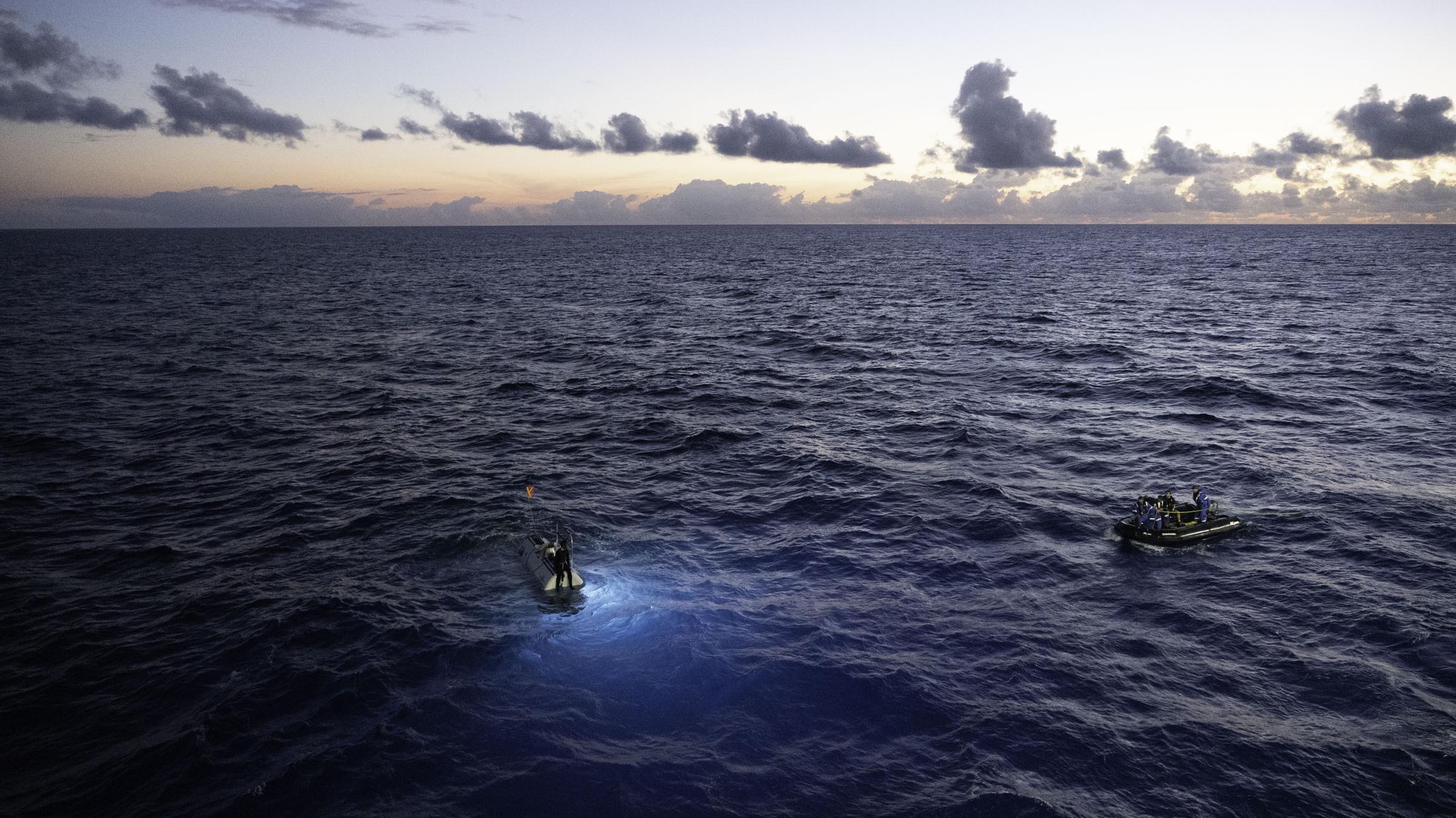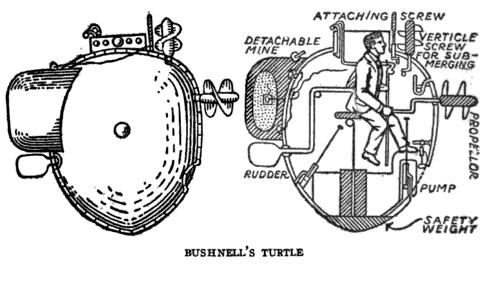|
Submersible
A submersible is an underwater vehicle which needs to be transported and supported by a larger ship, watercraft or dock, platform. This distinguishes submersibles from submarines, which are self-supporting and capable of prolonged independent operation at sea. There are many types of submersibles, including both human-occupied vehicles (HOVs) and uncrewed craft, variously known as remotely operated vehicles (ROVs) or unmanned underwater vehicles (UUVs). Submersibles have many uses including oceanography, underwater archaeology, ocean exploration, tourism, underwater work, equipment maintenance and underwater search and recovery, recovery and underwater videography. History The first recorded self-propelled underwater vessel was a small oar-powered submarine conceived by William Bourne (mathematician), William Bourne (c. 1535 – 1582) and designed and built by Dutch inventor Cornelis Drebbel in 1620, with two more improved versions built in the following four years.Konstam (201 ... [...More Info...] [...Related Items...] OR: [Wikipedia] [Google] [Baidu] |
Submarine
A submarine (often shortened to sub) is a watercraft capable of independent operation underwater. (It differs from a submersible, which has more limited underwater capability.) The term "submarine" is also sometimes used historically or informally to refer to remotely operated vehicles and Autonomous underwater vehicle, robots, or to medium-sized or smaller vessels (such as the midget submarine and the wet sub). Submarines are referred to as ''boats'' rather than ''ships'' regardless of their size. Although experimental submarines had been built earlier, submarine design took off during the 19th century, and submarines were adopted by several navies. They were first used widely during World War I (1914–1918), and are now used in many navy, navies, large and small. Their military uses include: attacking enemy surface ships (merchant and military) or other submarines; aircraft carrier protection; Blockade runner, blockade running; Ballistic missile submarine, nuclear deterrenc ... [...More Info...] [...Related Items...] OR: [Wikipedia] [Google] [Baidu] |
Full Ocean Depth
''Limiting Factor'', known as ''Bakunawa'' since its sale in 2022, is a crewed deep-submergence vehicle (DSV) manufactured by Triton Submarines and owned and operated since 2022 by Gabe Newell's Inkfish ocean-exploration research organization. It currently holds the records for the deepest crewed dives in all five oceans. ''Limiting Factor'' was commissioned by Victor Vescovo for $37 million and operated by his marine research organization, Caladan Oceanic, between 2018 and 2022. It is commercially certified by DNV for dives to full ocean depth, and is operated by a pilot, with facilities for an observer. The vessel was used in the Five Deeps Expedition, becoming the first crewed submersible to reach the deepest point in all five oceans. Over 21 people have visited Challenger Deep, the deepest area on Earth, in the DSV. ''Limiting Factor'' was used to identify the wrecks of the destroyers at a depth of , and at , in the Philippine Trench, the deepest dives on wrecks. It ha ... [...More Info...] [...Related Items...] OR: [Wikipedia] [Google] [Baidu] |
Turtle (submersible)
''Turtle'' (also called ''American Turtle'') was the world's first submersible vessel with a documented record of use in combat. It was built in 1775 by American David Bushnell (inventor), David Bushnell as a means of attaching Naval mine, explosive charges to ships in a harbor, for use against the Royal Navy during the American Revolutionary War. Connecticut Governor Jonathan Trumbull recommended the invention to George Washington, who provided funds and support for the development and testing of the machine. Several attempts were made using ''Turtle'' to affix explosives to the undersides of British warships in New York Harbor in 1776. All failed, and her transport ship was sunk later that year by the British with the submarine aboard. Bushnell claimed eventually to have recovered the machine, but its final fate is unknown. Modern replicas of ''Turtle'' have been constructed and are on display in the Connecticut River Museum, the U.S. Navy's Submarine Force Library and Muse ... [...More Info...] [...Related Items...] OR: [Wikipedia] [Google] [Baidu] |
David Bushnell (inventor)
David Bushnell (August 30, 1740 – 1824) was an American inventor, Patriot (American Revolution), patriot, teacher, and a medical doctor. Bushnell invented the first submarine to be used in battle, ''Turtle (submersible), Turtle'', as well as a floating mine triggered by contact. He was a veteran of the American Revolutionary War, Revolutionary War. Early life David Bushnell was born in a secluded part of Saybrook, Connecticut on 30 August 1740 and baptized in 1753 into a farming family in what is now Westbrook, Connecticut where his parents Nehemiah Bushnell and Sarah (Susan) Ingham Bushnell owned a farm. He was the first of five children born. Following the death of his father circa 1769, he sold his half interest in the family Westbrook farm to his brother Ezra and entered Yale University, Yale College in 1771 at the relatively old age of 31. The ''Turtle'' submarine Bushnell is credited with creating the first submarine ever used in combat, while studying at Yale in 177 ... [...More Info...] [...Related Items...] OR: [Wikipedia] [Google] [Baidu] |
Remotely Operated Vehicle
A remotely operated underwater vehicle (ROUV) or remotely operated vehicle (ROV) is a free-swimming submersible craft used to perform underwater observation, inspection and physical tasks such as valve operations, hydraulic functions and other general tasks within the subsea oil and gas industry, military, scientific and other applications. ROVs can also carry tooling packages for undertaking specific tasks such as pull-in and connection of flexible flowlines and umbilicals, and component replacement. They are often used to do research and commercial work at great depths beyond the capacities of most submersibles and divers. Description This meaning is different from remote control vehicles operating on land or in the air because ROVs are designed specifically to function in underwater environments, where conditions such as high pressure, limited visibility, and the effects of buoyancy and water currents pose unique challenges. While land and aerial vehicles use wireless commu ... [...More Info...] [...Related Items...] OR: [Wikipedia] [Google] [Baidu] |
Underwater Work
Underwater work is work done underwater, generally by divers during Underwater diving, diving operations, but includes work done underwater by remotely operated underwater vehicles and crewed submersibles. Underwater work is the activity required to achieve the purpose of the diving operation additional to the activities required for safe diving in the specific underwater environment of the worksite, including finding and identifying the workplace, and where necessary, making it safe to do the planned work. Some of these activities have a wide range of applications in work suitable for a given diving mode, and are likely to be considered basic skills and learned during professional diver training programmes for the relevant mode. Others are specialist skils and are more likely to be learned on the job or on skills training programmes not directly related to diving. Occupational diving fields There are several occupational specialty fields in occupational diving, and the work done i ... [...More Info...] [...Related Items...] OR: [Wikipedia] [Google] [Baidu] |
Through-water Communications
Surface-supplied diving is a mode of underwater diving using equipment supplied with breathing gas through a diver's umbilical from the surface, either from the shore or from a diving support vessel, sometimes indirectly via a diving bell. This is different from scuba diving, where the diver's breathing equipment is completely self-contained and there is no essential link to the surface. The primary advantages of conventional surface supplied diving are lower risk of drowning and considerably larger breathing gas supply than scuba, allowing longer working periods and safer decompression. Disadvantages are the absolute limitation on diver mobility imposed by the length of the umbilical, encumbrance by the umbilical, and high logistical and equipment costs compared with scuba. The disadvantages restrict use of this mode of diving to applications where the diver operates within a small area, which is common in commercial diving work. The copper helmeted free-flow standard divi ... [...More Info...] [...Related Items...] OR: [Wikipedia] [Google] [Baidu] |
Underwater Archaeology
Underwater archaeology is archaeology practiced underwater. As with all other branches of archaeology, it evolved from its roots in pre-history and in the classical era to include sites from the historical and industrial eras. Its acceptance has been a relatively late development due to the difficulties of accessing and working underwater sites, and because the application of archaeology to underwater sites initially emerged from the skills and tools developed by shipwreck salvagers. As a result, underwater archaeology initially struggled to establish itself as actual archaeological research. This changed when universities began teaching the subject and a theoretical and practical base for the sub-discipline was firmly established in the late 1980s. Underwater archaeology now has a number of branches including, maritime archaeology: the scientifically based study of past human life, behaviors and cultures and their activities in, on, around and (lately) under the sea, estuarie ... [...More Info...] [...Related Items...] OR: [Wikipedia] [Google] [Baidu] |
Unmanned Underwater Vehicle
Unmanned underwater vehicles (UUV), also known as underwater drones, are submersible vehicles that can operate underwater without a human occupant. These vehicles may be divided into two categories: remotely operated underwater vehicles (ROUVs) and autonomous underwater vehicles (AUVs). ROUVs are remotely controlled by a human operator. AUVs are automated and operate independently of direct human input. Classifications Remotely operated underwater vehicle Remotely operated underwater vehicle, Remotely Operated Underwater Vehicles (ROUVs) is a subclass of UUVs with the primary purpose of replacing humans for underwater tasks due to the difficult underwater conditions. ROUVs are designed to perform educational or industrial missions. They are manually controlled by an operator to perform tasks that include surveillance and patrolling. The structure of ROUVs disqualify it from being able to operate autonomously. In addition to a camera, actuators, and sensors, ROUVs often incl ... [...More Info...] [...Related Items...] OR: [Wikipedia] [Google] [Baidu] |
Underwater Search And Recovery
Underwater search and recovery is the process of locating and recovering underwater objects, often by divers, but also by the use of submersibles, remotely operated vehicles and electronic equipment on surface vessels. Most underwater search and recovery is done by professional divers as part of commercial marine salvage operations, military operations, emergency services, or law enforcement activities. Minor aspects of search and recovery are also considered within the scope of recreational diving. Professional search and recovery The scope of professional search and recovery includes the following applications: *Marine archeology - search for artifacts of historical interest and importance, and where applicable the recovery of such artifacts for study. *Marine salvage - search for lost material of value and recovery thereof *Environmental protection - search for environmentally undesirable material and disposal thereof *Forensic S&R - search for and recovery of material r ... [...More Info...] [...Related Items...] OR: [Wikipedia] [Google] [Baidu] |
Ship
A ship is a large watercraft, vessel that travels the world's oceans and other Waterway, navigable waterways, carrying cargo or passengers, or in support of specialized missions, such as defense, research and fishing. Ships are generally distinguished from boats, based on size, shape, load capacity and purpose. Ships have supported Geographic exploration, exploration, Global trade, trade, Naval warfare, warfare, Human migration, migration, colonization, and science. Ship transport is responsible for the largest portion of world commerce. The word ''ship'' has meant, depending on the era and the context, either just a large vessel or specifically a Full-rigged ship, ship-rigged sailing ship with three or more masts, each of which is Square rig, square-rigged. The earliest historical evidence of boats is found in Egypt during the 4th millennium BCE. In 2024, ships had a global cargo capacity of 2.4 billion tons, with the three largest classes being ships carrying dry bulk (43%), ... [...More Info...] [...Related Items...] OR: [Wikipedia] [Google] [Baidu] |










